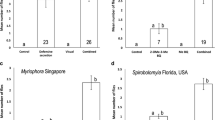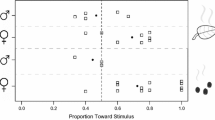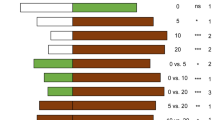Abstract
Larvae of the leaf beetle Chrysomela lapponica derive a defensive secretion from salicyl glucosides found in the host plant Salix borealis. This secretion protects beetle larvae from some natural enemies, but does not appear to repel parasitoids. We tested the hypothesis that the fly parasitoid Megaselia opacicornis (Diptera, Phoridae) uses the larval defensive secretion of Ch. lapponica in its search for prey. In the field, nearly 30 times more M. opacicornis individuals were caught on leaves coated with sticky resin next to a source of secretion than on control leaves. In the laboratory, M. opacicornis females laid six times more eggs next to a cotton ball soaked in secretion than next to one soaked in water. Fly females also lay more eggs on prey rich in larval secretion than on secretion-poor prey. In the field, removal of defensive secretion from beetle prepupae resulted in a 7.5-fold reduction of oviposition by fly females. Parasitoids were nearly twice as likely to lay eggs on prepupae, rich in secretion, as on pupae, which contain little secretion. Fly offspring reared from beetle prepupae reached a 21% larger body mass than those reared from pupae. Finally, M. opacicornis females avoided host prepupae already parasitized by the tachinid fly Cleonice nitidiuscula, which possess little secretion. These experiments indicate that host plant-derived defensive secretions are used by this parasitoid for host location. Adaptation of parasitoids to use defensive secretions of hosts may selectively favor an increase in diet breadth in specialist herbivores.



Similar content being viewed by others
References
Blum MS (1994) Antipredator devices in larvae of the Chrysomelidae: a unified synthesis for defensive eclecticism. In: Jolivet PH, Cox ML, Petitpierre E (eds) Novel aspects of the biology of Chrysomelidae, vol 50. Kluwer, Dordrecht, pp 277–288
Brown WL, Eisner T, Whittaker RH (1970) Allomones and kairomones: transpecific chemicals messengers. BioScience 20:21–22
Chabora PC, Pimentel D (1977) Effects of host (Musca domestica Linnaeus) age on the pteromalid parasite Nasonia vitripennis. Can Entomol 98:1226–1231
Denno RF, Larsson S, Olmstead KL (1990) Role of enemy-free space and plant quality in host-plant selection by willow beetles. Ecology 71:124–137
Dicke M, Sabelis MW (1988) Infochemical terminology: based on cost-benefit analysis rather than origin of compounds. Funct Ecol 2:131–139
Godfray HCJ (1994) Parasitoids: behavioural and evolutionary ecology. Princeton University Press, Princeton
Gratton C, Welter SC (1999) Does “enemy-free space” exist? Experimental host shifts of an herbivorous fly. Ecology 80:773–785
Gross J (2001) On the evolution of host plant specialization in leaf beetles (Coleoptera: Chrysomelina). Inaugural-Dissertation zur Erlangung des Doktorgrades. Institut für Biologie—Angewandte Zoologie/Oekologie der Tiere, Freie Universität Berlin
Gross J, Hilker M (1995) Chemoecological studies of the exocrine glandular larval secretion of two chrysomelid species (Coleoptera): Phaedon cochleariae and Chrysomela lapponica. Chemoecology 5(6):185–189
Hilker M, Schulz S (1994) Composition of larval secretion of Chrysomela lapponica (Coleoptera, Chrysomelidae) and its dependence on host plant. J Chem Ecol 20:1075–1093
Julkunen-Tiitto R (1989) Distribution of certain phenolics in Salix species (Salicaceae). Univ Joensuu Publ Sci 15:1–19
Kanervo V (1946) Tutkimuksia lepän lehtikuoriaisen, Melasoma aenea L. (Col., Chrysomelidae), luontaisista vihollisista. [Studien über die natürlichen Feinde des Erlenblattkäfers, Melasoma aenea L. (Col., Chrysomelidae)]. Ann Zool Soc Zool-Bot Fenn Vanamo 12:1–202
Köpf A, Rank N, Roininen H, Tahvanainen J (1997) Defensive larval secretions of leaf beetles attract a specialist predator Parasyrphus nigritarsis. Ecol Entomol 22:176–183
Lawton JH (1986) The effect of parasitoids on phytophagous insect communities. In: Waage J, Greathead D (eds) Insect parasitoids. Academic, London, pp 265–289
Mattiacci L, Vinson SB, Williams HJ, Aldrich JR, Bin F (1993) A long-range attractant kairomone for egg parasitoid Trissolcus basalis, isolated from defensive secretion of its host, Nezara viridula. J Chem Ecol 19:1167–1181
Palokangas P, Neuvonen S (1992) Differences between species and instars of leaf beetles in the probability to be preyed on. Ann Zool Fenn 29:273–278
Paré PW, Lewis WJ, Tumlinson JH (1999) Induced plant volatiles: biochemistry and effects on parasitoids. In: Agrawal AA, Tuzun S, Bent E (eds) Induced plant defenses against pathogens and herbivores. APS Press, St. Paul, pp 167–180
Pasteels JM, Rowell-Rahier M (1992) The chemical ecology of herbivory on willows. Proc R Soc Edinb 98B:63–73
Pasteels JM, Braekman JC, Daloze D, Ottinger R (1982) Chemical defence in chrysomelid larvae and adults. Tetrahedron 38:1891–1897
Pasteels JM, Daloze D, Rowell-Rahier M (1986) Chemical defense in chrysomelid eggs and neonate larvae. Physiol Entomol 11:29–37
Pasteels JM, Braekman JC, Daloze DD (1988) Chemical defense in the Chrysomelidae. In: Jolivet P, Petitpierre E, Hsiao TH (eds) Biology of chrysomelidae, vol 42. Kluwer, Dordrecht, pp 233–260
Rank NE (1994) Host plant effects on larval survival in a salicin-using leaf beetle Chrysomela aeneicollis (Coleoptera: Chrysomelidae). Oecologia 97:342–353
Rank NE, Smiley JT (1994) Host-plant effects on Parasyrphus melanderi Curran (Diptera: Syrphidae) feeding on a willow leaf beetle Chrysomela aeneicollis Schaeffer (Coleoptera: Chrysomelidae). Ecol Entomol 19:31–38
Rank NE, Smiley JT, Köpf A (1996) Natural enemies and host plant relationships for chrysomeline leaf beetles feeding on Salicaceae. In: Jolivet PH, Cox ML (eds) Chrysomelidae biology, vol 2. Ecological studies. SPB Publishing, Amsterdam, pp 147–171
Rank NE, Köpf A, Julkunen-Tiitto R, Tahvanainen J (1998) Host preference and larval performance of the salicylate-using leaf beetle Phratora vitellinae. Ecology 79:618–631
Richter VA, Zvereva EL (1996) The tachinid species Cleonice nitidiuscula Zetterstedt new for fauna of Murmansk Province (Diptera: Tachinidae). Zoosyst Rossica 6:202
Schulz S, Gross J, Hilker M (1997) Origin of defensive secretion of the leaf beetle Chrysomela lapponica. Tetrahedron 53:9203–9212
Sengonca Ç, Liu B (1994) Responses of the different instar predator, Coccinella septempunctata L. (Coleoptera: Coccinellidae), to the kairomones produced by the prey and non-prey insects as well as the predator itself. J Plant Dis Prot 101:173–177
Smiley JT, Horn JH, Rank NE (1985) Ecological effects of salicin at three trophic levels: new problems from old adaptations. Science 229:649–651
Tahvanainen J, Helle E, Julkunen-Tiitto R, Lavola A (1985) Phenolic compounds of willow bark as deterrents against feeding by mountain hare. Oecologia 65:319–323
Topp W, Bell D (1992) Melasoma vigintipunctata (Scop.): ein Weidenblattkäfer mit Massenvermehrung. Faun Ökol Mitt 6:267–286
Turlings TCJ, Tumlinson JH, Lewis WJ, Vet LEM (1990) Exploitation of herbivore-induced plant odors by host-seeking parasitic wasps. Science 250:1251–1253
Vet LEM, Dicke M (1992) Ecology of infochemical use by natural enemies in a tritrophic context. Annu Rev Entomol 37:141–172
Zvereva EL, Kozlov MV (2000) Effects of air pollution on natural enemies of the leaf beetle Melasoma lapponica. J Appl Ecol 37:298–308
Zvereva EL, Rank NE (2003) Host plant effects on parasitoid attack on the leaf beetle Chrysomela lapponica. Oecologia 135:258–267
Zvereva EL, Kozlov MV, Neuvonen S (1995a) Decrease of feeding niche breadth of Melasoma lapponica (Coleoptera: Chrysomelidae) with increase of pollution. Oecologia 104:323–329
Zvereva EL, Kozlov MV, Neuvonen S (1995b) Population density and performance of Melasoma lapponica (Coleoptera: Chrysomelidae) in surroundings of a smelter complex. Environ Entomol 24:707–715
Zvereva EL, Kozlov MV, Haukioja E (1997a) Population dynamics of a herbivore in an industrially modified landscape: case study with Melasoma lapponica (Coleoptera: Chrysomelidae). Acta Phytopathol Entomol Hung 32:251–258
Zvereva EL, Kozlov MV, Niemelä P, Haukioja E (1997b) Delayed induced resistance and increase in leaf fluctuating asymmetry as responses of Salix borealis to insect herbivory. Oecologia 109:368–373
Acknowledgements
We thank V. Zverev and A. Vasiljev for assistance in the field. This study was financially supported by the Academy of Finland.
Author information
Authors and Affiliations
Corresponding author
Rights and permissions
About this article
Cite this article
Zvereva, E.L., Rank, N.E. Fly parasitoid Megaselia opacicornis uses defensive secretions of the leaf beetle Chrysomela lapponica to locate its host. Oecologia 140, 516–522 (2004). https://doi.org/10.1007/s00442-004-1602-7
Received:
Accepted:
Published:
Issue Date:
DOI: https://doi.org/10.1007/s00442-004-1602-7




